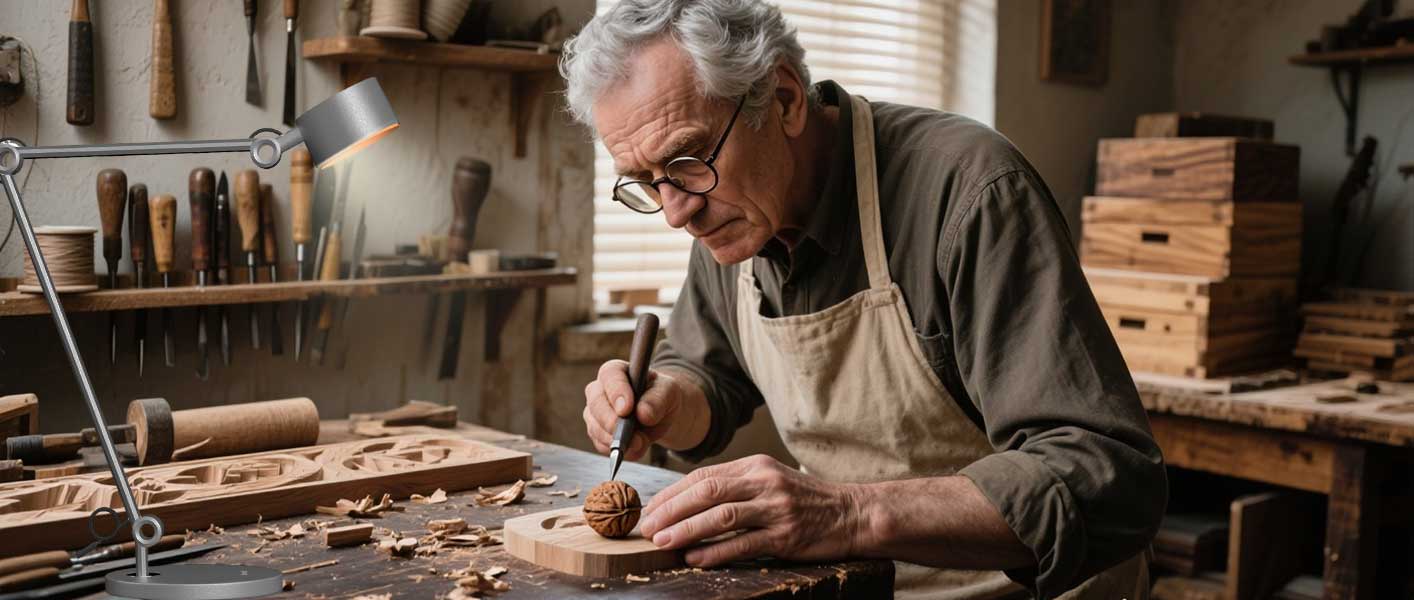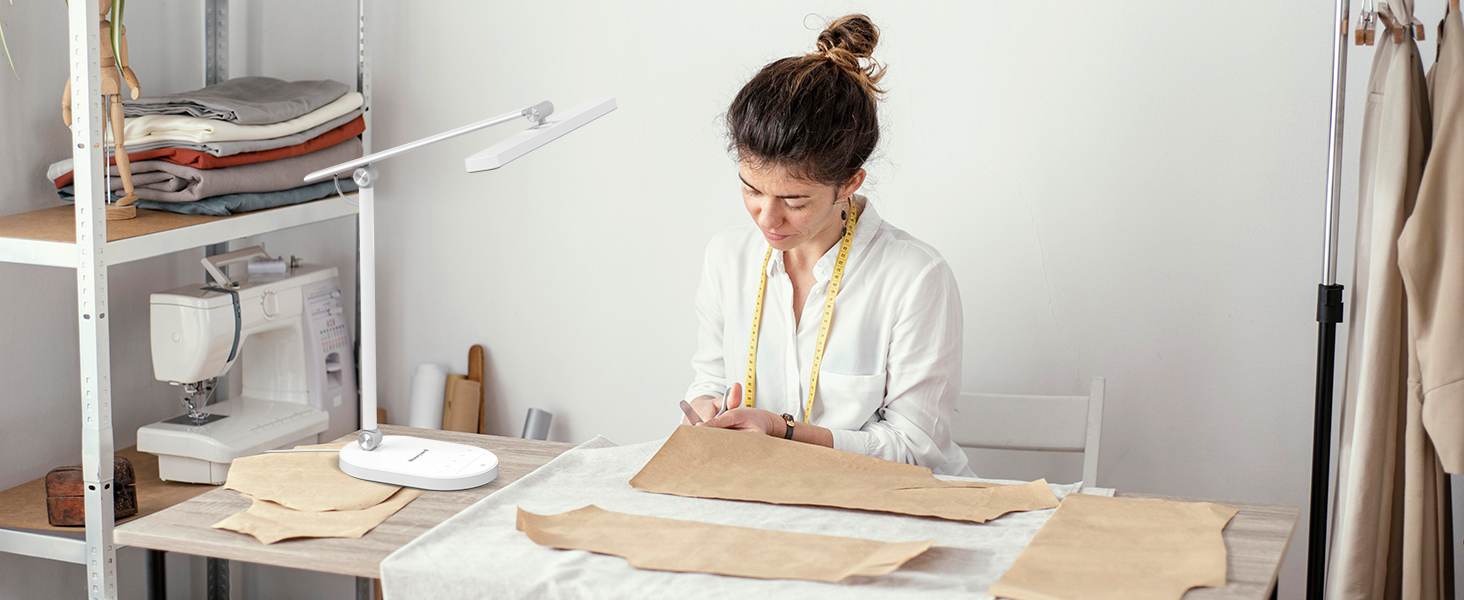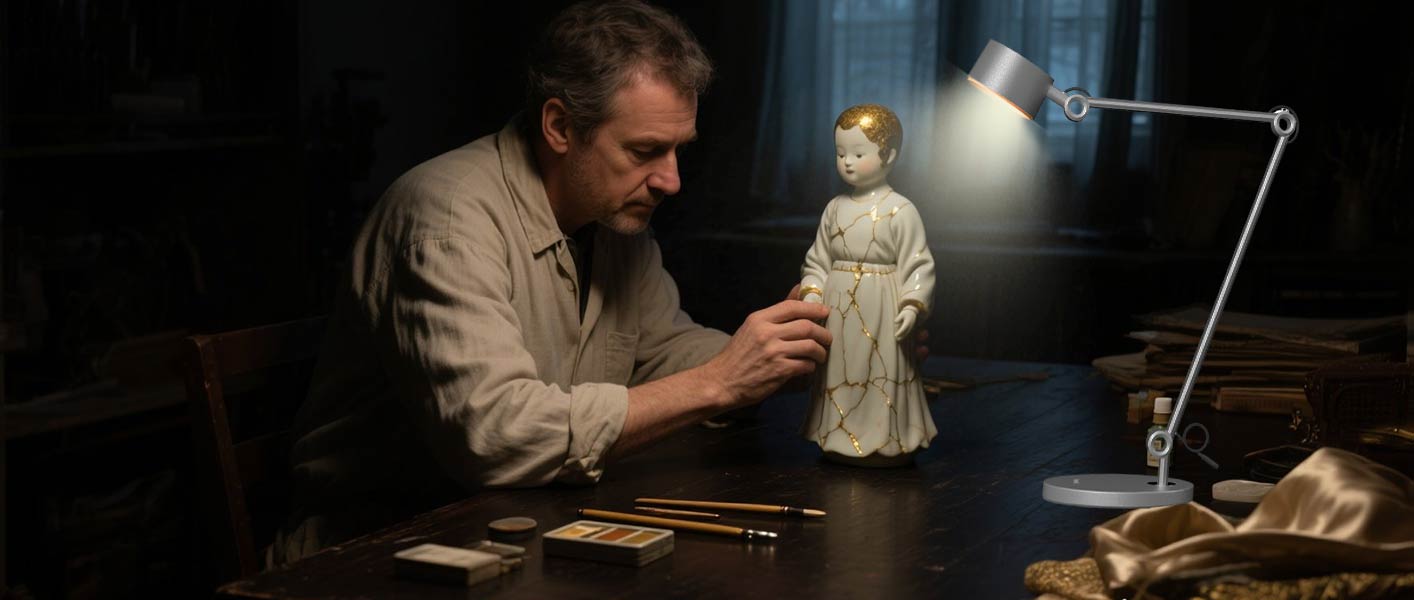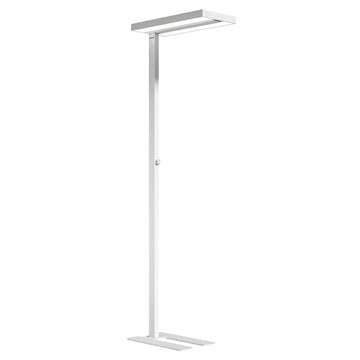The Unseen Strain Behind Handcrafted Beauty
Every precise incision with a 0.5 mm carving knife. Every gear aligned within a micro-mechanical structure. Every thread coiled into elegant wire-wrapped jewelry. These are the fruits of immense concentration and artistic patience. Yet beneath the beauty of detail-focused handcraft lies an invisible toll: aching eyes, blurry vision, and tension headaches that appear like clockwork.
For makers, crafters, and miniature artisans, poor lighting isn't a minor inconvenience—it’s a creative hindrance. Standard desk lamps often fail to support the high-precision, high-immersion visual demands these crafts require. That’s why choosing the right desk lamp isn’t just a comfort—it’s a critical creative decision.
In this guide, we dive into the visual challenges behind different types of detail-oriented desk crafts, decode what good lighting actually means for each, and introduce professional lighting solutions like the Honeywell HWT-01A and the more accessible HWT-H4W—engineered not just for visibility, but for visual accuracy and endurance.
1. Miniature Models and Dioramas: Lighting Every Microscopic Detail
Visual Challenges:
Crafters building dioramas, scale architectural models, or 1:12 dollhouse miniatures operate in a world where a single misplaced drop of glue or uneven paint wash can ruin hours of work. Under low or uneven lighting, shadow casting becomes a major issue, especially when assembling tiny components or layering textures like moss, gravel, and wood grain.
Lighting Needs:
-
Uniform, shadow-free illumination across a 3–4 ft workspace.
-
High Color Rendering Index (CRI) to distinguish subtle pigment variations.
-
Adjustable lighting angle for multi-level or enclosed model areas.

Recommended Lamp:
The Honeywell HWT-01A is an ideal companion for miniature artists. With its broad LED panel and ultra-high CRI, it provides accurate lighting across textured surfaces and prevents tunnel vision from harsh contrast. Its flexible arm lets users focus light even inside tiny architectural spaces without disrupting work posture.
2. Precision Mechanics: The Clockmaker’s Dilemma
Visual Challenges:
For mechanical hobbyists building kinetic sculptures, wood gear models, or DIY clocks, the problem isn’t just seeing—but aligning, timing, and calibrating. Even a 1 mm offset in gear placement can sabotage a mechanism. Traditional lamps often produce flicker or glare, triggering eye strain during long calibration sessions.
Lighting Needs:
-
Flicker-free, stable light for mechanical consistency.
-
Focused beam control to inspect joints, axles, and gears.
-
Minimal heat emission to avoid distorting delicate parts.

Recommended Lamp:
The Honeywell HWT-H4W, while budget-friendly, includes a precise beam-control design and anti-glare diffusion. It’s especially well-suited for mechanical assembly zones with high demand for focal lighting and long work periods.
3. Microscopic Crafting: When Carving or Embroidery Goes Submillimeter
Visual Challenges:
Whether it's nut carving, eraser stamp carving, or French knot embroidery, many crafts require following pre-marked lines or guiding tools along a near-microscopic path. Standard ceiling or task lights create inconsistent shadows and lack the crispness needed to define submillimeter edges.
Lighting Needs:
-
Ultra-close lighting clarity at under 12 inches.
-
Crisp illumination with neutral temperature to highlight surface depth.
-
No shadow zones or hot spots around tools or hands.

Recommended Lamp:
The Honeywell HWT-01A again shines here, with its minimal visual distortion and adjustable neck that allows users to light the workspace at sharp angles—critical when carving or embroidering with minute patterns.
4. Wire Wrapping & Jewelry Making: Balance in the Details
Visual Challenges:
Wire wrapping jewelry involves silver threads, gemstones, and precise balance. Tiny reflections from tools or gemstones can mislead hand positioning, and distinguishing between silver wire gauges can become frustrating under cool or dim lighting.
Lighting Needs:
-
Warm-to-neutral lighting for true metal color distinction.
-
Broad beam coverage without glare.
-
Non-obtrusive design to avoid tool collisions.

Recommended Lamp:
The HWT-H4W, with its sleek vertical stem and customizable brightness settings, allows jewelry artists to switch between ambient and focused light depending on whether they are coiling, securing, or polishing.
5. Papercraft and Pop-Up Book Design: Engineering Meets Art
Visual Challenges:
Paper sculptors and pop-up book designers often work with scoring tools, creasing knives, and adhesive rulers. Their projects blend fine motor skills with spatial visualization, and visual strain tends to spike during assembly phases.
Lighting Needs:
-
Even light field over an A3 (11.7 × 16.5 in) cutting mat.
-
High shadow control to prevent misalignment during folding.
-
Light tone suitable for white and color paper differentiation.

Recommended Lamp:
The HWT-01A is a master of spread. Its edge-lit diffusion avoids harsh top-down light that can reflect off glossy paper. Its generous reach ensures entire cutting mats are well-lit without shifting materials.
6. Textile and Fiber Arts: The Thread-Level Perspective
Visual Challenges:
From micro-knitting to Irish lacework, textile artists need to count threads, maintain even tension, and identify minute fiber variations. Overhead lighting rarely aligns well with hand positions, and poor contrast can make yarn work nearly impossible.
Lighting Needs:
-
Strong vertical beam flexibility to track thread movement.
-
Adjustable brightness to match fabric colors and textures.
-
Heat-free light to prevent material warping.

Recommended Lamp:
The HWT-H4W handles these needs with its vertical adjustability and slim base, ensuring close, heat-free lighting that doesn't interfere with hand movement or material flow.
7. Scientific Handcrafts: Lighting for Precision and Preservation
Visual Challenges:
For crafters working with entomology, resin encasing, or mineral polishing, visual exactness is crucial—not only for crafting but for preservation accuracy. These artists often work under magnification, and inconsistent lighting can interfere with both microscopic vision and resin curing.
Lighting Needs:
-
Magnifier-compatible lighting setups.
-
Low-UV light for resin work.
-
Color-true lighting to judge mineral cuts or biological specimens.

Recommended Lamp:
The HWT-01A integrates seamlessly with auxiliary lenses and resin-safe lighting. It can light a magnified workspace without adding UV stress—perfect for preserving specimen clarity.
Conclusion: Light as the Ultimate Tool of Craft
True craftsmanship isn’t only in the hands; it begins with the eyes. For detail-oriented hobbyists and professional crafters alike, choosing a quality desk lamp like the Honeywell HWT-01A or HWT-H4W ensures your vision is empowered, not exhausted.
Whether you're wiring a tiny amethyst pendant or setting gears in a wooden clock, the right light doesn’t just help you see—it helps you create with confidence.









